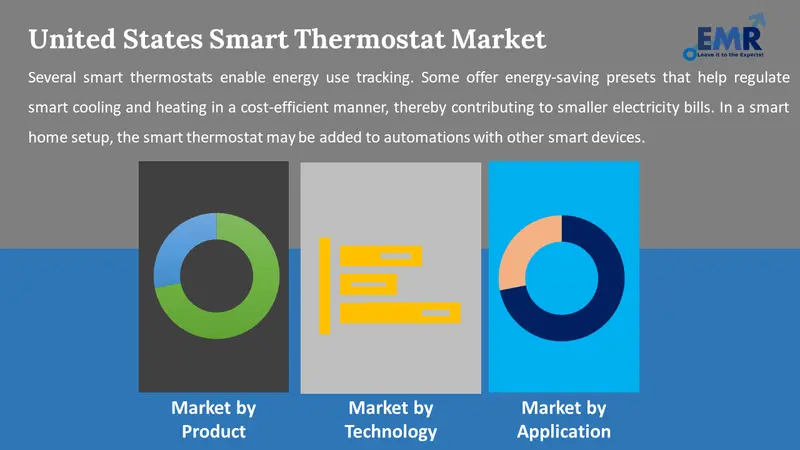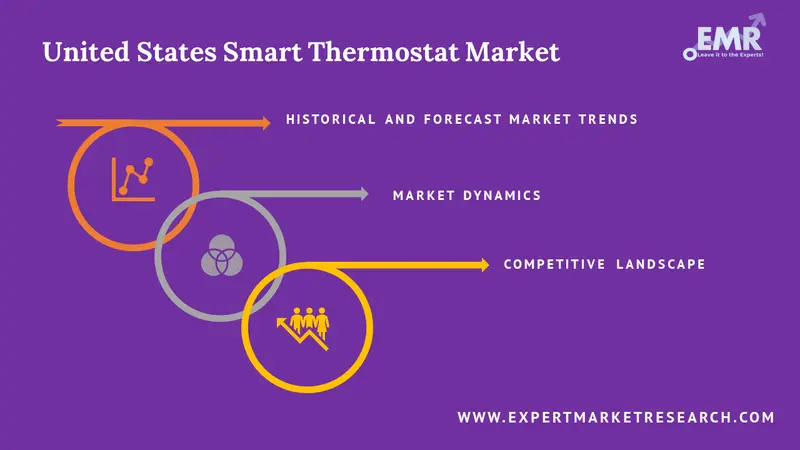
Consumer Insights
Uncover trends and behaviors shaping consumer choices today
Procurement Insights
Optimize your sourcing strategy with key market data
Industry Stats
Stay ahead with the latest trends and market analysis.
The United States smart thermostat market would likely grow at a CAGR of 16.90% during 2026-2035. Smart thermostats manage a home's cooling and heating; generally, smart thermostats are app-enabled devices and offer several different features.
Base Year
Historical Period
Forecast Period
Compound Annual Growth Rate
16.9%
2026-2035
*this image is indicative*
Being smart devices, several thermostats may be regulated through voice command. Some smart thermostats employ occupancy sensors to ascertain if the resident is home or outside to automatically change temperature. Many thermostats automatically shift between away and home modes on the basis of the phone's location of the resident. Certain devices use remote temperature and proximity sensors to increase the detection range of the thermostat to other areas of the house.
Most smart thermostats are connected through Wi-Fi to an app on the consumer’s phone. The app is used to schedule and regulate heating or cooling, and modify the temperature of the house; it may also set up automations with other smart devices. There also are programmable thermostats that are not connected with an app, but are capable of scheduling cooling and heating routines via a touchscreen display.
Smart thermostat makes life easier as it may be scheduled to heat early in the morning to avoid the chill in the air, or initiate air conditioning some time before entering the house to find it cool. Smart thermostats with apps don’t require a person to get up to make changes to the temperature. This feature is particularly useful for individuals with mobility challenges.
Smart thermostats may act as safety devices when linked to a fire-listening device or smart smoke alarms. In the event of a fire, the thermostat automatically switches off the HVAC to prevent the spread of fire due to blowing air.
Modern smart thermostats display some useful features. For example, smart thermostats exhibit learning. Learning thermostats memorizes schedules to automatically change the temperature to suit consumers’ needs. Learning routines may also help save money on cooling and heating as the HVAC system, heat pump, or furnace will not run when not needed.
Such features are expected to boost the United States smart thermostat market.
Many smart thermostats allow adjustment of temperature via voice command to Amazon Alexa, Google Assistant, and Apple’s Siri. So even if the phone is not close enough, temperature may be adjusted through a simple voice command.

Read more about this report - REQUEST FREE SAMPLE COPY IN PDF
Several smart thermostats enable energy use tracking. Some offer energy-saving presets that help regulate smart cooling and heating in a cost-efficient manner, thereby contributing to smaller electricity bills. In a smart home setup, the smart thermostat may be added to automations with other smart devices. An automation may be created to lower the thermostat, turn off smart lights, and arm the smart home security system. Such features are expected to boost the United States smart thermostat market
Popular smart thermostats include Ecobee Smart Thermostat Premium, Nest Learning Thermostat v.3, Amazon Smart Thermostat, Honeywell RTH8580WF Wi-Fi Thermostat, Nest Thermostat, Ecobee3 Lite, Sensibo Sky, Nest Thermostat E, Honeywell Home T9 Smart Thermostat, and others.

Read more about this report - REQUEST FREE SAMPLE COPY IN PDF
The EMR’s report titled “United States Smart Thermostat Market Report and Forecast 2026-2035 offers a detailed analysis of the market based on the following segments:
By product, the market is segmented into:
By technology, the market is divided into:
By application, the market is classified into:
By region, the market is segmented into:
The report offers an extensive assessment of major players in the United States smart thermostat market; it evaluates their capability, observes latest occurrences such as mergers and acquisitions, capacity expansions, and plant turnarounds:
Using SWOT analysis and Porter’s Five Forces model, the EMR report offers deep insights into the industry.




*While we strive to always give you current and accurate information, the numbers depicted on the website are indicative and may differ from the actual numbers in the main report. At Expert Market Research, we aim to bring you the latest insights and trends in the market. Using our analyses and forecasts, stakeholders can understand the market dynamics, navigate challenges, and capitalize on opportunities to make data-driven strategic decisions.*
Get in touch with us for a customized solution tailored to your unique requirements and save upto 35%!
The market is projected to grow at a CAGR of 16.90% between 2026 and 2035.
The major drivers of the market are rising energy costs, increasing consumer awareness, and improving standards of living.
The key trends guiding the growth of the market include remote controlled smart thermostats via smartphones and other devices, inclusion of further smart features, and research and development activities to develop advanced products.
The major regions in the United States smart thermostat market are New England, Mideast, Great Lakes, Plains, Southeast, Southwest, Rocky Mountain, and Far West.
Connected, standalone, and learning are the various products of smart thermostats in the market.
Technologies used for smart thermostat are wired and wireless, with wireless further subdivided into Wi-Fi, Bluetooth, and Zigbee, among others.
The different applications of smart thermostats in the market are commercial, residential, and industrial.
Smart thermostats are intelligent and improved versions of traditional thermostats that can regulate the cooling and heating of a home of building based on various parameters such as remote instructions, occupancy, or weather, among others.
Smart thermostats support greater ease and accuracy in temperature management as compared to traditional thermostats, helping reduce cooling and heating expenses while maintaining comfortable temperatures.
The major players in the market are Honeywell International Inc, Johnson Controls, Emerson Electric Co., Carrier Corporation, Bosch Thermotechnology Corp., Lux Products Corporation, ecobee Inc., Vivint, Inc, Radio Thermostat Company of America, and Lennox International Inc., among others.
Explore our key highlights of the report and gain a concise overview of key findings, trends, and actionable insights that will empower your strategic decisions.
| REPORT FEATURES | DETAILS |
| Base Year | 2025 |
| Historical Period | 2019-2025 |
| Forecast Period | 2026-2035 |
| Scope of the Report |
Historical and Forecast Trends, Industry Drivers and Constraints, Historical and Forecast Market Analysis by Segment:
|
| Breakup by Product |
|
| Breakup by Technology |
|
| Breakup by Application |
|
| Breakup by Region |
|
| Market Dynamics |
|
| Trade Data Analysis |
|
| Competitive Landscape |
|
| Companies Covered |
|
Datasheet
One User
USD 2,499
USD 2,249
tax inclusive*
Single User License
One User
USD 3,999
USD 3,599
tax inclusive*
Five User License
Five User
USD 4,999
USD 4,249
tax inclusive*
Corporate License
Unlimited Users
USD 5,999
USD 5,099
tax inclusive*
*Please note that the prices mentioned below are starting prices for each bundle type. Kindly contact our team for further details.*
Flash Bundle
Small Business Bundle
Growth Bundle
Enterprise Bundle
*Please note that the prices mentioned below are starting prices for each bundle type. Kindly contact our team for further details.*
Flash Bundle
Number of Reports: 3
20%
tax inclusive*
Small Business Bundle
Number of Reports: 5
25%
tax inclusive*
Growth Bundle
Number of Reports: 8
30%
tax inclusive*
Enterprise Bundle
Number of Reports: 10
35%
tax inclusive*
How To Order

Select License Type
Choose the right license for your needs and access rights.

Click on ‘Buy Now’
Add the report to your cart with one click and proceed to register.

Select Mode of Payment
Choose a payment option for a secure checkout. You will be redirected accordingly.
Gain insights to stay ahead and seize opportunities.

Get insights & trends for a competitive edge.

Track prices with detailed trend reports.

Analyse trade data for supply chain insights.

Leverage cost reports for smart savings

Enhance supply chain with partnerships.

Connect For More Information
Our expert team of analysts will offer full support and resolve any queries regarding the report, before and after the purchase.
Our expert team of analysts will offer full support and resolve any queries regarding the report, before and after the purchase.
We employ meticulous research methods, blending advanced analytics and expert insights to deliver accurate, actionable industry intelligence, staying ahead of competitors.
Our skilled analysts offer unparalleled competitive advantage with detailed insights on current and emerging markets, ensuring your strategic edge.
We offer an in-depth yet simplified presentation of industry insights and analysis to meet your specific requirements effectively.
Share